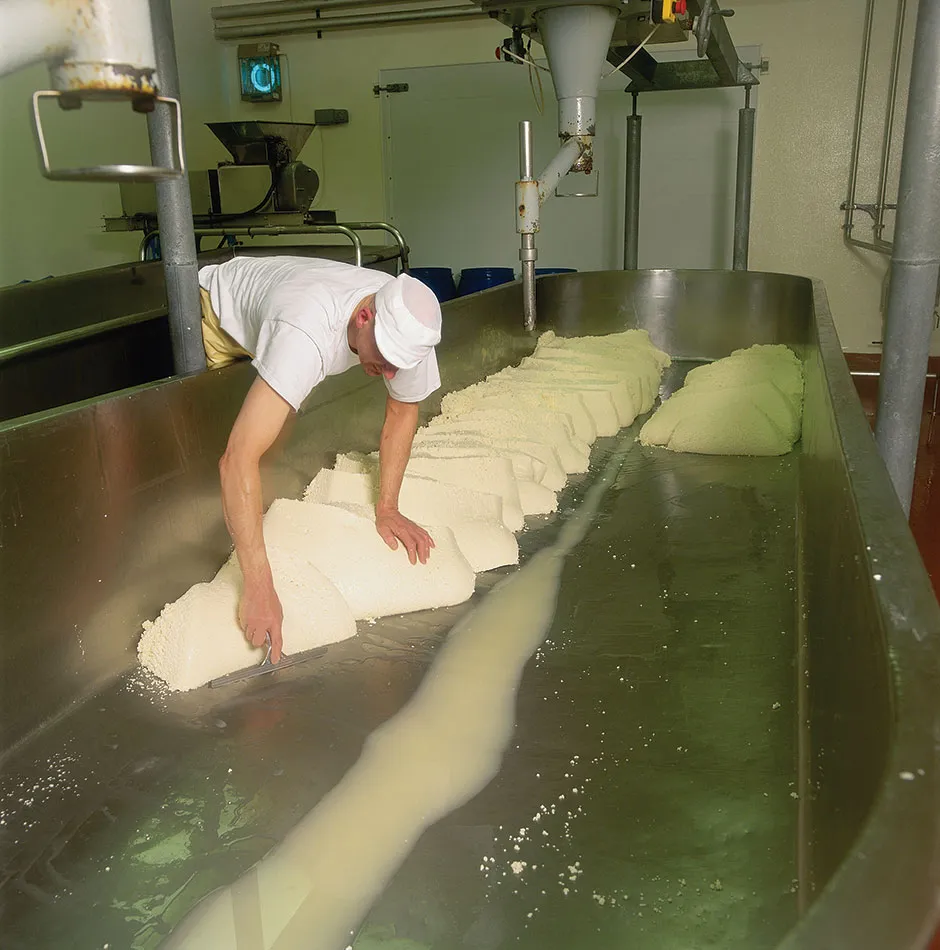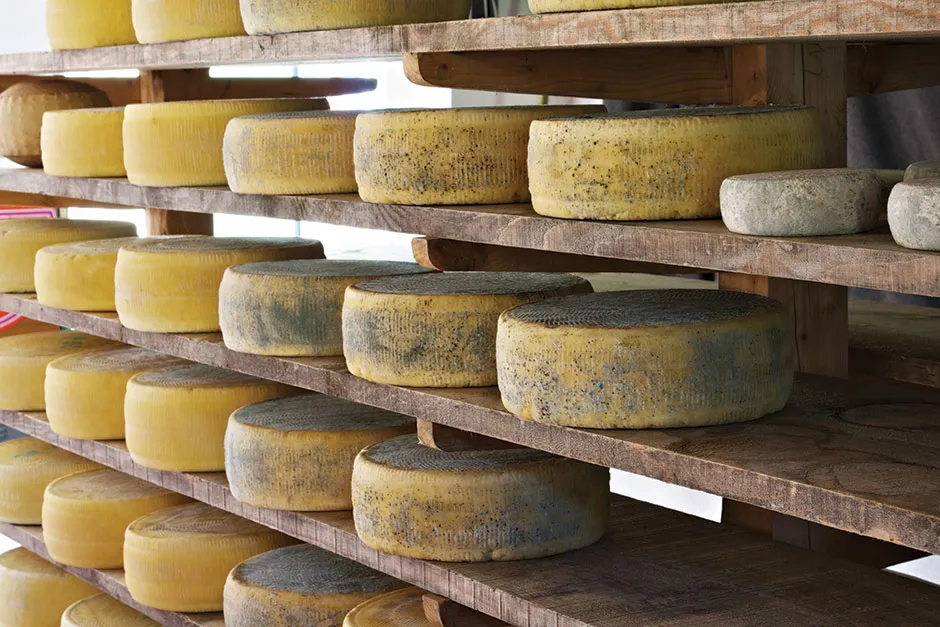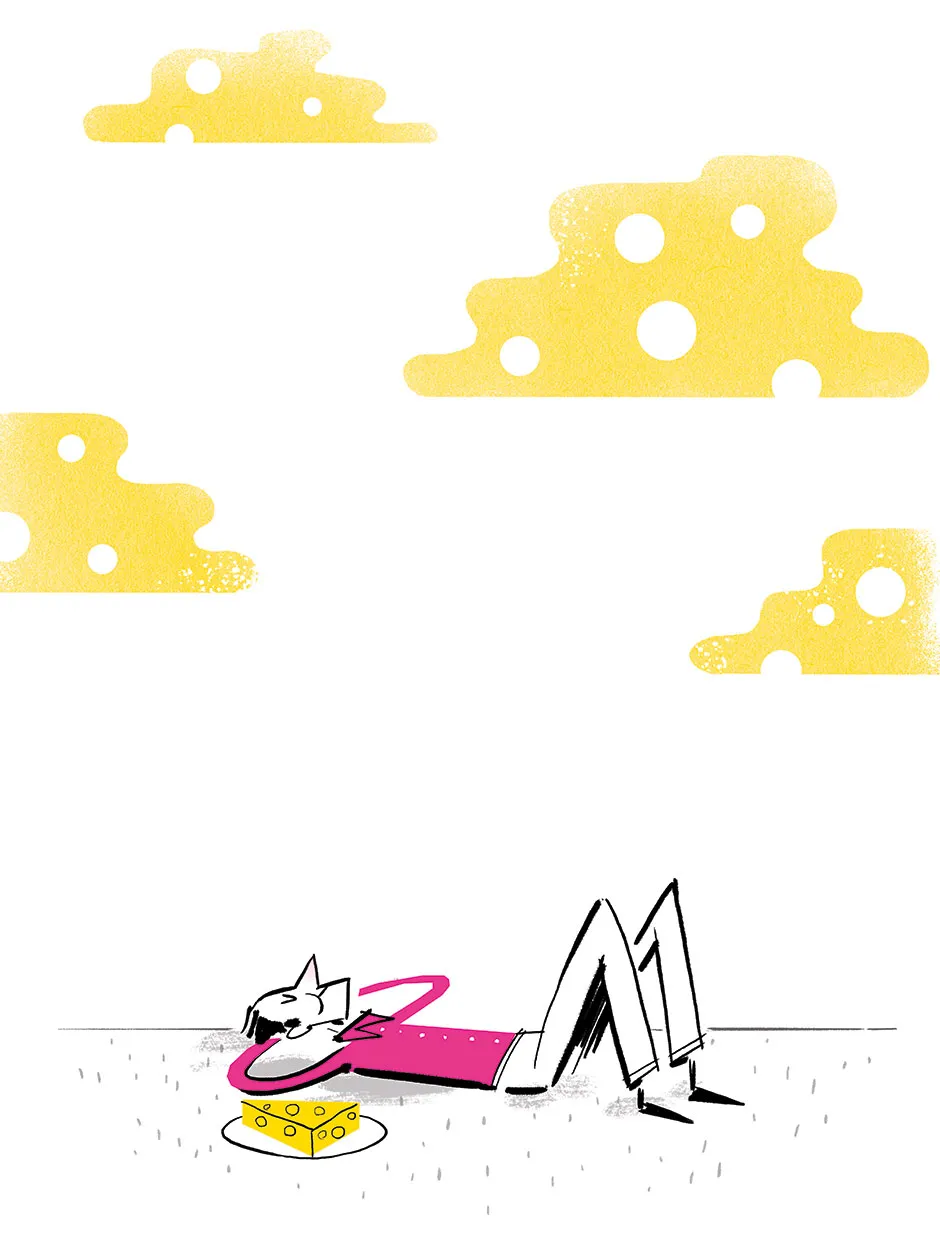Who would have thought that a congealed lump of curdled milk could be so delicious? When milk and microbes come together, there’s no doubt something wonderful happens. So how does a choreography of chemistry, biology and psychology make cheese the ultimate food, something so addictively moreish?
For 7,000 years, cheese has titillated the taste buds of humanity. In almost every corner of the world, animal milk has been used to create the stuff, culminating in over 1,700 distinct varieties today: creamy Brie; buttery Gouda; crumbly Parmesan; stringy mozzarella; sharp Cheddar; holey Swiss; mild paneer; smoky Bavarian Emmentaler… the list goes on and on.

The staggering variety of cheeses is testimony to the creativity of cheesemakers throughout the ages, but their ingenuity plays second fiddle to the real stars of the show: the microbes.
The several-hundred-strong ensemble cast of bacteria, fungi and yeasts bring life to a bland, salty lump of off-white curd. By digesting, or ‘fermenting’, the fats, proteins and milk sugars, they spew forth a complex selection of flavourful – sometimes smelly – molecules.
Never has second-hand food tasted so good! But what is it that makes cheese so devilishly moreish?
From milk to cheese
All cheeses start their lives as milk. Most animal milks can be used, including cow, buffalo, goat, sheep and even camel. The milk is first warmed to a temperature perfect for milk-loving microbes to flourish.
Next, acid or rennet is added, possibly alongside some ‘starter’ bacteria. This causes the milk proteins and fats to coagulate together into ugly white clumps, ‘curdling’ the milk. These fat-laden ‘curds’ then float to the surface of the milky liquid, the ‘whey’.
The curds can then be drained, removed and chopped into chunks, according to the type of cheese being made – walnut-sized blobs for soft cheeses, and small grains for hard cheeses.

The curds are scooped into moulds, but the initial ‘starter’ bacteria, which give cheese its lactic acid tang, die off over several weeks to make room for a microbe superhighway of new flavour generators. Plenty of salt is added to the mix to stop any rancid milk-loving microbes from spoiling the brew.
In the months that follow, a second wave of hungry ‘ripening’ microorganisms gradually start munching into the cheese to create the potent flavours and aromas. These ripening microbes chew off portions of the proteins, breaking them into their amino acid component parts – many of which have their own flavour.
Tryptophan, for example, has a bitter taste. Alanine tastes sweet, while glutamate directly stimulates the umami taste receptors and is responsible for a cheese’s savoury flavour.
Read more about the science of cheese:
- Microbes in cheese: the bacteria that bring unique flavours and texture
- Why is mozzarella cheese so stretchy?
- Does eating blue cheese contribute to antibiotic resistance?
This umami kick is commonly found in fermented and high-protein foods, as well as seaweed and tomatoes. When glutamate is added to foods (typically as the unfairly maligned MSG, or monosodium glutamate), it gives it a ‘just-one-more-bite’ addictive quality.
Particularly voracious bacteria and fungi will break down amino acids even further to produce truly whiffy by-products that are identical to those found in nature’s pongiest places. Chemicals produced by cheese microbes include putrescine, which is responsible for the smell of putrid meat; trimethylamine, which gives rotten fish its room-clearing odour; and ammonia, which carries the fragrance of toilet cleaner.
The source of cheese's flavour
The journey doesn’t stop there, thankfully, and over months of further ripening, smelly fragments can interact and recombine in new ways to produce more appetising flavour-carrying molecules. These substances convey notes that can be nutty, spicy, woody, grassy, or even have hints of burnt oats.
Fat is also chief among cheese’s moreish appeal – it makes pretty much anything taste good. With a few provisos, the more fat a food contains, the tastier it becomes.
We crave this calorie-packed nutrient due to our evolutionary programming, as it will give us fuel to survive the next famine. Fat’s irresistible allure is partly due to fat-sensitive receptors on the tongue, which is why low-fat alternatives never quite have the same appeal.
It’s not out of the question that we have cheese that smells like socks because at some point in the dim and distant past, someone’s feet got a bit too close to the curds
Any food’s aroma- and flavour-carrying substances are known collectively as ‘flavour compounds’. They typically dissolve well in oils, fats and alcohol, but poorly in water.
Fat-rich foods will therefore have their flavour compounds infused and well spread throughout, meaning that each mouthful will smother the tongue with a flavour that lingers, while also giving ample time for these easily vaporised compounds to waft up the back of the throat into the nose as aromas where our nasal receptors interpret them as a ‘taste’ that comes from the tongue.
It’s not just proteins that microorganisms munch on. Some microorganisms are also fat-digesters, such as the Penicillium moulds found in blue cheese. They break down fats into small molecules, some of which have a peppery taste and carry sheep/goat-milk aromas, while others give it an off-putting stink.

One of these substances, known as mushroom alcohol, or octenol, has a ‘mouldy’ smell that is also found in breath and sweat. Mushroom alcohol also attracts biting insects, so keep your cheese covered and your skin clean on a hot day!
The real humdinger stinky cheeses, such as Munster and Limburger, emit vapours that contain molecules identical to those given off from old socks, and also harbour the same bacteria.
Called Brevibacterium, this is a so-called ‘smear’ bacteria that can grow on the moist outer surface of cheese, nibbling away and releasing chemicals such as butyric acid, which is responsible for the repulsive smell of vomit, along with methanethiol, which smells putrid.
Brevibacterium also flourishes in the damp recesses between warm toes and it’s not out of the question that the reason we have cheese that smells like socks in the first place is because at some point in the dim and distant past, someone’s feet got a bit too close to the curds.
Whiffy cheese
Interestingly, we are all born with a natural aversion to such putrid smells, yet over time we learn to adore these intuitively unpleasant aromas. Furthermore, tiny traces of repulsive smells and flavours are sensed as pleasant, for reasons that no one really understands.
Skatole, for example, gives poo its unmistakable whiff, yet in minute amounts it smells floral and perfumers use it in the stuff we splash on our necks.
Read more about food science:
- The science of the perfect cup of tea
- How to make a sandwich, the perfect sandwich, using science
- 7 recipe books to tantalise your scientific senses
Humans seem to have a touch of gastronomic masochism, getting a thrill when nastiness accompanies our pleasures: bitterness – a warning sign for poison – is one of coffee’s qualities, while tingling chilli heat is an essential component of curry.
These sensations also explain why the cheeseboard is so irresistible, even after a gut-busting meal. Our ‘dessert stomach’ is due to ‘sensory specific satiety’ – our food-obsessed minds crave novelty. When we have a new flavour offered, the desire to try something novel shortcuts our satiety and encourages us to tuck in.

It’s testament to this moreishness that there have been some scientific-sounding claims bandied about that cheese is as ‘addictive as cocaine’ because it contains opium-like chemicals called casomorphin peptides – small bits of broken-down curd protein that happen to bear chemical similarities to the poppy-derived narcotic.
If casomorphins made it into the brain after a cheese feast, then they could latch onto opioid receptors, numbing pain and giving a euphoric boost, much like morphine.
However, if you plan on using cheese’s mind-altering powers to excuse your Wensleydale obsession, then you are clutching at (cheese) straws: casomorphin also happens to be in milk and other dairy products, and compared to many morphine-like substances, any effects due to casomorphin are pretty tame. It turns out you are ‘addicted’ to cheese, just because it tastes so good.
- This article first appeared inissue 351ofBBC Science Focus–find out how to subscribe here
The Science of Cooking by Dr Stuart Farrimond is out now (£20, DK).
- Buy it now from Amazon UK, Waterstones or WH Smith